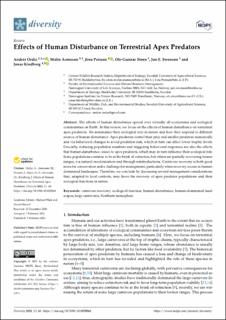| dc.contributor.author | Ordiz Fernandez, Andres Avelino | |
| dc.contributor.author | Aronsson, Malin | |
| dc.contributor.author | Persson, Jens | |
| dc.contributor.author | Støen, Ole-Gunnar | |
| dc.contributor.author | Swenson, Jon | |
| dc.contributor.author | Kindberg, Jonas | |
| dc.date.accessioned | 2021-11-24T07:56:28Z | |
| dc.date.available | 2021-11-24T07:56:28Z | |
| dc.date.created | 2021-02-12T09:53:08Z | |
| dc.date.issued | 2021 | |
| dc.identifier.issn | 1424-2818 | |
| dc.identifier.uri | https://hdl.handle.net/11250/2831172 | |
| dc.description.abstract | The effects of human disturbance spread over virtually all ecosystems and ecological communities on Earth. In this review, we focus on the effects of human disturbance on terrestrial apex predators. We summarize their ecological role in nature and how they respond to different sources of human disturbance. Apex predators control their prey and smaller predators numerically and via behavioral changes to avoid predation risk, which in turn can affect lower trophic levels. Crucially, reducing population numbers and triggering behavioral responses are also the effects that human disturbance causes to apex predators, which may in turn influence their ecological role. Some populations continue to be at the brink of extinction, but others are partially recovering former ranges, via natural recolonization and through reintroductions. Carnivore recovery is both good news for conservation and a challenge for management, particularly when recovery occurs in humandominated landscapes. Therefore, we conclude by discussing several management considerations that, adapted to local contexts, may favor the recovery of apex predator populations and their ecological functions in nature. carnivore recovery; ecological function; human disturbance; human-dominated landscapes; large carnivores; Northern hemisphere | |
| dc.language.iso | eng | |
| dc.title | Effects of Human Disturbance on Terrestrial Apex Predators | |
| dc.type | Peer reviewed | |
| dc.type | Journal article | |
| dc.description.version | publishedVersion | |
| dc.subject.nsi | VDP::Zoologiske og botaniske fag: 480 | |
| dc.subject.nsi | VDP::Zoology and botany: 480 | |
| dc.source.journal | Diversity | |
| dc.identifier.doi | 10.3390/d13020068 | |
| dc.identifier.cristin | 1889070 | |
| dc.relation.project | Andre: Norwegian Environment Agency | |
| dc.relation.project | Andre: Austrian Science Fund | |
| dc.relation.project | Andre: Swedish Environmental Protection Agency | |
| dc.relation.project | Egen institusjon: Norwegian institute for nature research (NINA) | |
| cristin.ispublished | true | |
| cristin.fulltext | original | |
| cristin.qualitycode | 1 | |
